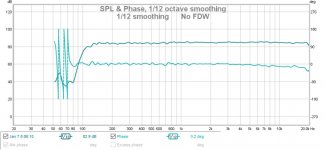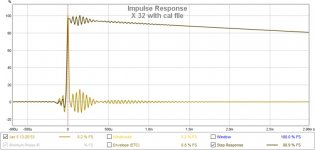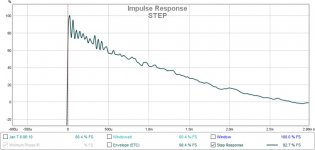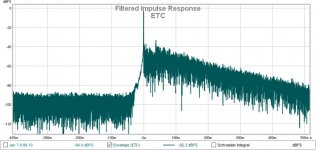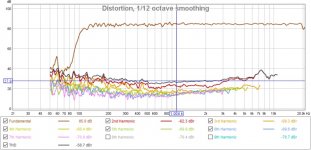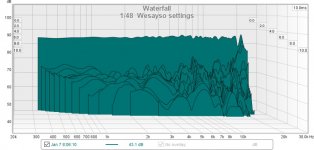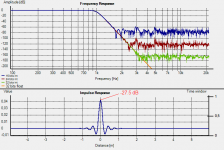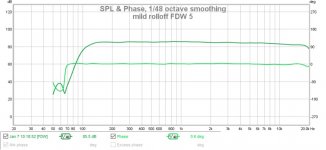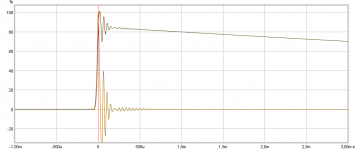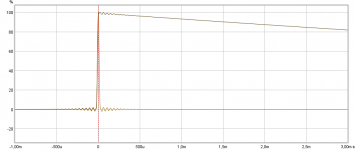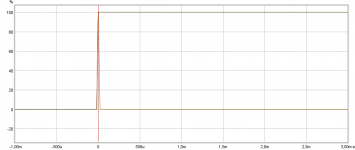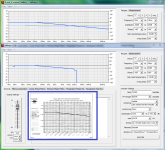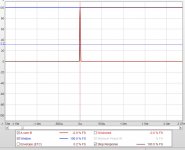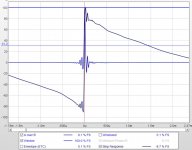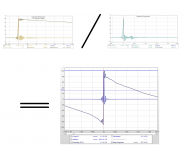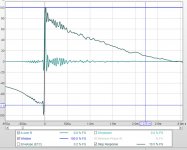Thanks guys,
can you post Impulse Responses with STEP?
Here's the x-32.....
I don't know how to measure IR of ICICLE, but ... If you want I can measure after 10 January, one of speaker (BMS 4590, JBL2012, JBL2440 or Aurasound 1808) with same mic setup with 5 sound cards, ICICLE, ASUS Essence STX, M-Audio Delta 66, RME HDSP 32-96, and some on-board Realtec. All measurements I can post here.
But I really need XLR / phantom power for most of the measurements I make.
Anybody measured or seen measurements for a really clean, reasonably priced, conventional mic soundcard?
I am alsp interested in a good reasonably priced mic soundcard (via usb) with phantom power. My preference would be a relatively small one.
Regards
@ Kjeldsen, twest820, & 3ll3d00d
Thanks for the info on Focusrite, and especially for impulse plot.
Sounds like everyone is very pleased with their Focusrite models.
@ mpa
That is very good for a pro box, or I should say for any I've seen.
Like Draki said, the Four Audio unit uses a downsampling technique that puts it in a type of its own, making direct tap comparisons not really apply.
Here's a link Four Audio | FIR Filters: calculation power, length of impulse responses, and frequency resolution
@ jtalden
I tried my two behringer soundcards, UMC 404 and 1820, at 96 kHz.
I could see how the impulse oscillations were pulled up in time, with no second batch of oscillations like at 48 kHz. I guess this is the benefit of pushing out nyquist. I need to delve into this further...don't really understand it yet. I've ended up using the x-32 as a soundcard right now just because it makes for one less piece of gear in the measurement chain...
@ Mark
I'm not sure there is a typical use yet, but IMO the number of taps needed for a rough estimation, really just boils down to how much phase rotation at lowest frequency are you trying to undo. Convert that rotation to time, and then see how many taps divided by whatever sampling rate your processor is using, are needed to equal that time. Hope that made sense...
@ ustas
That would be a heck of a set of measurements...nice !
I just look at the impulse response of the soundcard's measurement after applying its calibration file. Like found in REW's initial soundcard calibration proceedure.
Thanks for the info on Focusrite, and especially for impulse plot.
Sounds like everyone is very pleased with their Focusrite models.
@ mpa
That is very good for a pro box, or I should say for any I've seen.
Like Draki said, the Four Audio unit uses a downsampling technique that puts it in a type of its own, making direct tap comparisons not really apply.
Here's a link Four Audio | FIR Filters: calculation power, length of impulse responses, and frequency resolution
@ jtalden
I tried my two behringer soundcards, UMC 404 and 1820, at 96 kHz.
I could see how the impulse oscillations were pulled up in time, with no second batch of oscillations like at 48 kHz. I guess this is the benefit of pushing out nyquist. I need to delve into this further...don't really understand it yet. I've ended up using the x-32 as a soundcard right now just because it makes for one less piece of gear in the measurement chain...
@ Mark
I'm not sure there is a typical use yet, but IMO the number of taps needed for a rough estimation, really just boils down to how much phase rotation at lowest frequency are you trying to undo. Convert that rotation to time, and then see how many taps divided by whatever sampling rate your processor is using, are needed to equal that time. Hope that made sense...
@ ustas
That would be a heck of a set of measurements...nice !
I just look at the impulse response of the soundcard's measurement after applying its calibration file. Like found in REW's initial soundcard calibration proceedure.
Last edited:
Hi all, back with round two of measurements, after taking in the pointers everyone provided earlier. Special thanks to Wesayso, who helped me offline.
What I learned...first, as several of you told me, alot of the impulse wiggles when zoomed in, are from AD/DA conversion in our soundcards.
Second, as also told, the rounding of the top of the STEP function straightens when there is no HF magnitude rolloff.
Last, subtle adjustments continue to pay off. I've known that, but Wesayso pointed me to finer subtlety that I had previously attempted. It's really cool how when you fix something it shows up in all the various plots. But i guess it has to..I mean we only take one measurement and then look at it countless ways...reminds me of statistics haha
The graphs below are without HF rolloff.
Oh, I found a new way to do rolloff I REALLY like, because it's so damn simple, and doesn't require such a massive rework of EQs if you change the target curve.
New method: EQ flat. Then simply apply a separate bank of linear-phase shelving filters in rePhase. Very easy regenerations ! I didn't know linear-phase shelving was available in rePhase....😱
Anyway, graph time...really getting happy...especially with how this sounds 🙂
After the SPL plot, The next impulse plot is the x-32 mixer's USB card, followed by the speaker impulse plot which has to build on top of the soundcard.
Thanks to all again !
What I learned...first, as several of you told me, alot of the impulse wiggles when zoomed in, are from AD/DA conversion in our soundcards.
Second, as also told, the rounding of the top of the STEP function straightens when there is no HF magnitude rolloff.
Last, subtle adjustments continue to pay off. I've known that, but Wesayso pointed me to finer subtlety that I had previously attempted. It's really cool how when you fix something it shows up in all the various plots. But i guess it has to..I mean we only take one measurement and then look at it countless ways...reminds me of statistics haha
The graphs below are without HF rolloff.
Oh, I found a new way to do rolloff I REALLY like, because it's so damn simple, and doesn't require such a massive rework of EQs if you change the target curve.
New method: EQ flat. Then simply apply a separate bank of linear-phase shelving filters in rePhase. Very easy regenerations ! I didn't know linear-phase shelving was available in rePhase....😱
Anyway, graph time...really getting happy...especially with how this sounds 🙂
After the SPL plot, The next impulse plot is the x-32 mixer's USB card, followed by the speaker impulse plot which has to build on top of the soundcard.
Thanks to all again !
Attachments
The APL1S is a very interesting box, with versatile (and probably very good quality) I/Os and 4096 taps at hand (vs 6144 for the openDRC).
My biggest grip with it is the fact that the convolution is done with 24bit fixed points FIRs. This is fine for speaker correction (the intended target of the box) but can be a problem with filtering.
My biggest grip with it is the fact that the convolution is done with 24bit fixed points FIRs. This is fine for speaker correction (the intended target of the box) but can be a problem with filtering.
Attachments
Hi all, back with round two of measurements, after taking in the pointers everyone provided earlier. Special thanks to Wesayso, who helped me offline.
What I learned...first, as several of you told me, alot of the impulse wiggles when zoomed in, are from AD/DA conversion in our soundcards.
Second, as also told, the rounding of the top of the STEP function straightens when there is no HF magnitude rolloff.
Last, subtle adjustments continue to pay off. I've known that, but Wesayso pointed me to finer subtlety that I had previously attempted. It's really cool how when you fix something it shows up in all the various plots. But i guess it has to..I mean we only take one measurement and then look at it countless ways...reminds me of statistics haha
The graphs below are without HF rolloff.
Oh, I found a new way to do rolloff I REALLY like, because it's so damn simple, and doesn't require such a massive rework of EQs if you change the target curve.
New method: EQ flat. Then simply apply a separate bank of linear-phase shelving filters in rePhase. Very easy regenerations ! I didn't know linear-phase shelving was available in rePhase....😱
Anyway, graph time...really getting happy...especially with how this sounds 🙂
After the SPL plot, The next impulse plot is the x-32 mixer's USB card, followed by the speaker impulse plot which has to build on top of the soundcard.
Thanks to all again !
I think it's a result to be pretty pleased with! Well done! Is this without physical changes to the horn? (added damping)
The APL1S is a very interesting box, with versatile (and probably very good quality) I/Os and 4096 taps at hand (vs 6144 for the openDRC).
My biggest grip with it is the fact that the convolution is done with 24bit fixed points FIRs. This is fine for speaker correction (the intended target of the box) but can be a problem with filtering.
You're absolutely right. I didn't look at it before I posted. All I remembered was the hardware he has was aimed at the Pro market.
Is this without physical changes to the horn? (added damping)
Thanks !
No damping yet.
This was simply taking the time in rephase to manually zoom in and make many tiny adjustments.
I really like the ability of REW and rephase to work together on EQ, but I think after the first coarse EQ passover from REW to rephase, I'll probably just stick to manual adjustments directly in rephase. It's what I know best...
I have to repeat the linear-phase rephase shelving filter thingy method, if you haven't tried it.
Here's a first stab at a mild rolloff..took only 3 shelving filters and like all of 10 minutes to build and load.
Attachments
Rephase created 48kHz 32bit LPCM wav files to model ADC/DAC filter ringing imported in REW.
HP 5Hz BW 12dB/oct (IRR) - LP 24kHz LR 192dB/oct (IRR):
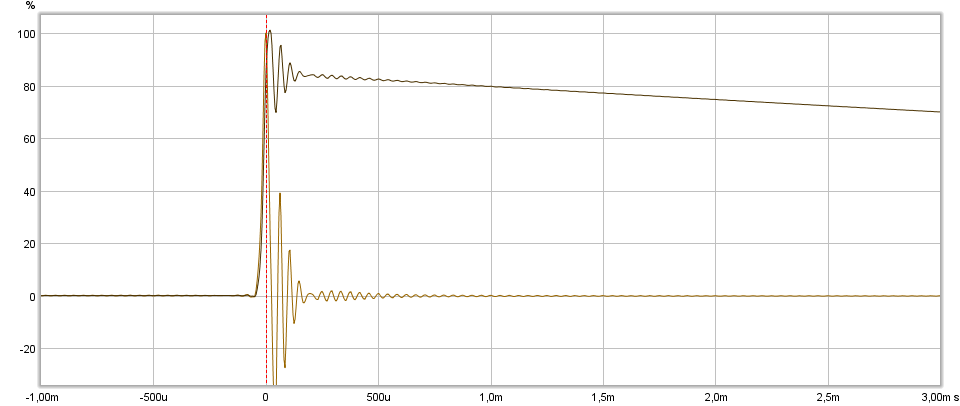
This is same but LP is FIR:
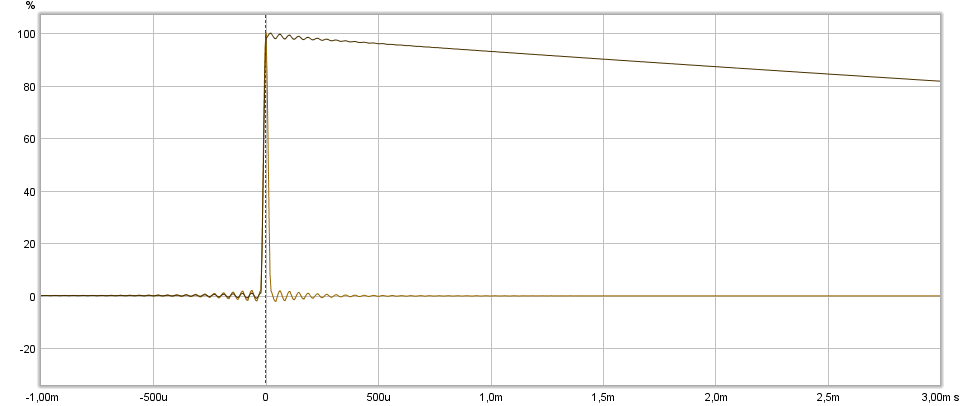
This result which is same for either IR above after at "ALL SPL" tab calculate IR over itself (A / B where same IR number are flagged for both A and B ):
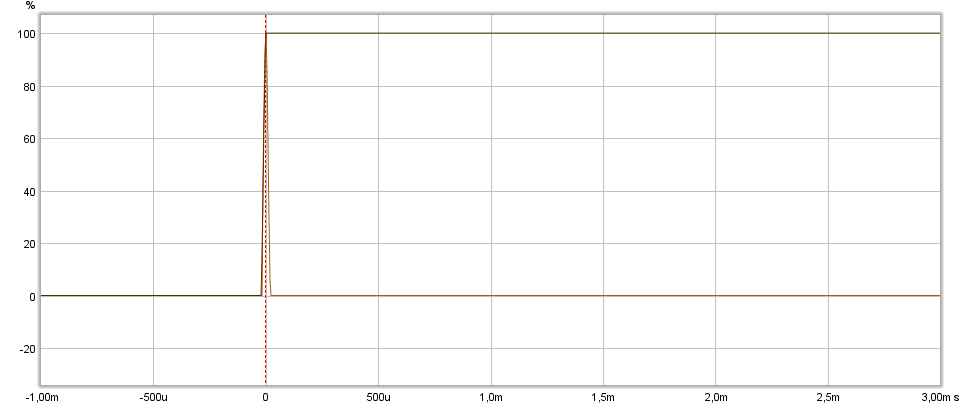
Based above think about would it work if mark100 for his system loop below calculate it over his sytem response and then we get the hash out.
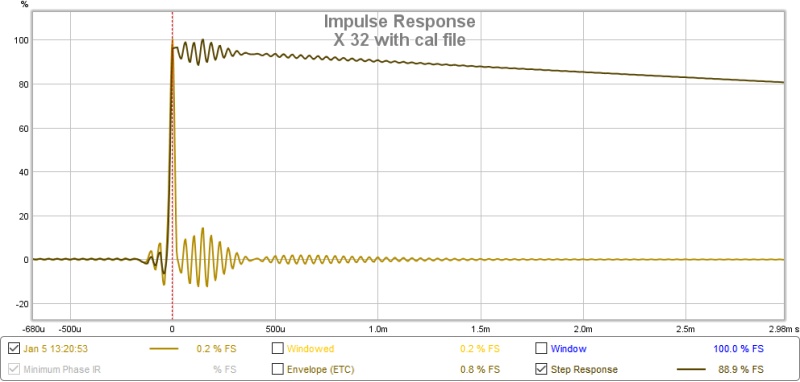
HP 5Hz BW 12dB/oct (IRR) - LP 24kHz LR 192dB/oct (IRR):
This is same but LP is FIR:
This result which is same for either IR above after at "ALL SPL" tab calculate IR over itself (A / B where same IR number are flagged for both A and B ):
Based above think about would it work if mark100 for his system loop below calculate it over his sytem response and then we get the hash out.

Attachments
...I have to repeat the linear-phase rephase shelving filter thingy method, if you haven't tried it.
Here's a first stab at a mild rolloff..took only 3 shelving filters and like all of 10 minutes to build and load.
Have traced B & K curve pretty precise out to 1mHz as IRR filter, attach it as Rephase settings file should anybody like it as a starting house curve. Phase don't turn much this IRR filter but should it be preferred as FIR just clone its settings and make them as FIR settings.
Attachments
Have traced B & K curve pretty precise out to 1mHz as IRR filter, attach it as Rephase settings file should anybody like it as a starting house curve. Phase don't turn much this IRR filter but should it be preferred as FIR just clone its settings and make them as FIR settings.
VERY NICE, thanks 🙂
...Also applied it to today's posted speaker measurement.
That look maybe too goo to be true 🙂 we can't see acoustic reflections anymore so if you have FDW turned on for today's speaker measurement can you try same math again but with default 500mS window.
Attachments
Last edited:
BYRTT, did you catch the part on the FR chart that said 1/12 smoothing, no FDW? 🙂
No BYRTT is right about the A/B posts...FDW 5 was on.
And you are right about posted SPL, FDW was off. I turned it on later in day to start comparing rolloff curves.
That look maybe too goo to be true 🙂 we can't see acoustic reflections anymore so if you have FDW turned on for today's speaker measurement can you try same math again but with default 500mS window.
I told you I have no idea what you're doing ! Or what results to expect haha.
OK I tried dividing the x-32 impulse by today's posted speaker measurement, per your chart.
Got a heck of a swirly display.
So I inverted, below is (non FDW) speaker divided by x-32 impulse..
Is this what you want ?
Attachments
I told you I have no idea what you're doing ! Or what results to expect haha.
OK I tried dividing the x-32 impulse by today's posted speaker measurement, per your chart.
Got a heck of a swirly display.
So I inverted, below is (non FDW) speaker divided by x-32 impulse..
Is this what you want ?
You right invert if it all is hash chaos, and haha i don't know if its correct but think if we divide the hash from loopback by itself and get a perfect impulse, then think it sounds logic that if we divide it to system response we have extracted that hash and see the real resonances and reflection so that visual you just posted is the better truth, by the way have you used "Estimate IR delay" because that could still make some small or mid changes to first hash.
Last edited:
JohnM gave described the fft-ifft approach in Export impulse response as wav (Including compensation of calibration mic) - Home Theater Forum and Systems - HomeTheaterShack.com , your approach seems logical though to me though
remember to reduce the level of the soundcard cal measurement to 0 dB (so as not to affect the level of the resulting calculated measurement) though
remember to reduce the level of the soundcard cal measurement to 0 dB (so as not to affect the level of the resulting calculated measurement) though
JohnM gave described the fft-ifft approach in Export impulse response as wav (Including compensation of calibration mic) - Home Theater Forum and Systems - HomeTheaterShack.com , your approach seems logical though to me though...
Thanks posting support because in long run if it works we can then ourselves when needed improve resolution these ringing interfaces and save some money : )
...remember to reduce the level of the soundcard cal measurement to 0 dB (so as not to affect the level of the resulting calculated measurement) though
...

, by the way have you used "Estimate IR delay" because that could still make some small or mid changes to first hash.
Hi, yes..."Estimate IR delay" has become a very routine step ...
Trying to learn more about arithmetic operations, A vs B......do you have any recommended links?
Going to 3ll3d00d's link now....
- Home
- Design & Build
- Software Tools
- rePhase, a loudspeaker phase linearization, EQ and FIR filtering tool
